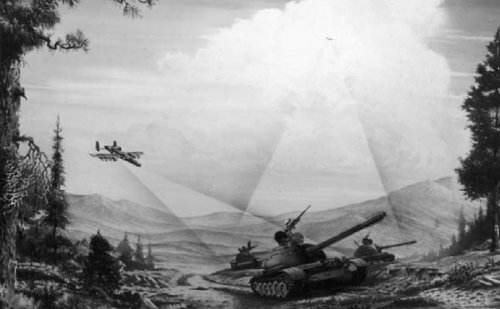- Joined
- 6 August 2007
- Messages
- 3,894
- Reaction score
- 5,974
In 1980s press reports of the "stealth fighter" before public disclosure of SENIOR TREND, the program name "CSIRS" for "Covert, Survivable In-Weather Reconnaisance/Strike" was mentioned as (possibly) being the "F-19" program.
This was actually a group of AF/DARPA programs that was intended to result in the Covert Strike Consolidated Demonstration (Covert Strike (PE 33103F Project 2831), Advanced Integrated Reference System, Weapon System Demonstration (PE 62601F), Automated Target Recognition). This was an outgrowth of the Covert Strike System Study (PE 62204F).
The primary component of the Covert Strike program was a bistatic radar system. A remote radar in a "sanctuary" would illunminate the target, while attacking aircraft or munitions would passively receiver reflected radar energy. The radar itself grew out of an earlier program, Tactical Bistatic Radar Demonstration (T-Bird). The Covert Strike effort existed as early as 1982, but seems to have become a formal program of record as a new start in 1984.
The system was to be demonstrated in concert with very low observable munitions dispensers, and the intent was to not only produce new-build Covert Strike capable radars but to retrofit the capability to existing systems (F-15, F-16, B-1). The munitions dispensers for this effort may have lead to HAVE SLICK and other similar programs of the 1980s and 1990s.
This was actually a group of AF/DARPA programs that was intended to result in the Covert Strike Consolidated Demonstration (Covert Strike (PE 33103F Project 2831), Advanced Integrated Reference System, Weapon System Demonstration (PE 62601F), Automated Target Recognition). This was an outgrowth of the Covert Strike System Study (PE 62204F).
The primary component of the Covert Strike program was a bistatic radar system. A remote radar in a "sanctuary" would illunminate the target, while attacking aircraft or munitions would passively receiver reflected radar energy. The radar itself grew out of an earlier program, Tactical Bistatic Radar Demonstration (T-Bird). The Covert Strike effort existed as early as 1982, but seems to have become a formal program of record as a new start in 1984.
The system was to be demonstrated in concert with very low observable munitions dispensers, and the intent was to not only produce new-build Covert Strike capable radars but to retrofit the capability to existing systems (F-15, F-16, B-1). The munitions dispensers for this effort may have lead to HAVE SLICK and other similar programs of the 1980s and 1990s.


